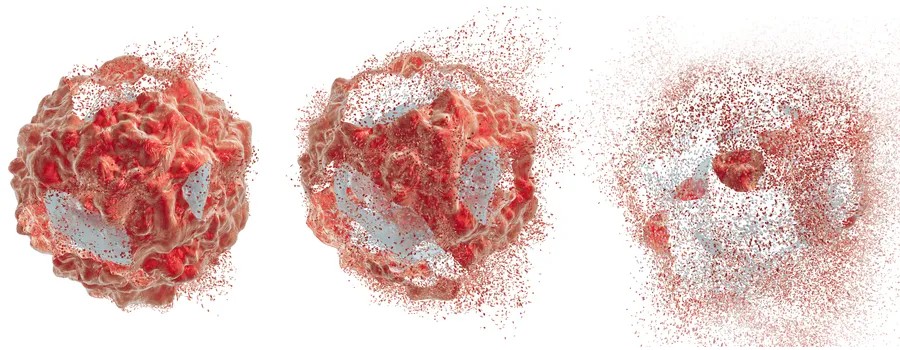
Graphic by Kateryna Kon, Shutterstock.
Stanford Medicine Scope - March 18th, 2019 - by Hanae Armitage
In any movie, the "self-destruct" button is usually the last resort, only opted for in the most dire of circumstances. But for a cell, pulling the plug on yourself can be more than an act of dramatic demise: Death is a sickly cell's way of protecting the rest of the body from illness.
In my latest magazine story, I feature Jan Carette, PhD, an associate professor of microbiology and immunology, and Scott Dixon, PhD, assistant professor of biology, two cell death aficionados who are investigating two forms of cell death — necroptosis and ferroptosis. While both scientists are after the basic mechanisms governing the death pathways, they're hopeful that what they find might benefit human health.
From the story:
As scientists learn more about the chemical interactions inside cells that lead to cell death, some are using that knowledge for therapeutics by inducing cell suicide to kill tumor cells or repressing it to temper rheumatoid arthritis and multiple sclerosis.
'It’s exciting to think about how we can induce cell death in the proper way to fend off or stunt illness,' said Carette. 'But first we need to understand how these modes of death occur, how they differ and how they intersect. That’s what will drive therapeutics.'
Carette's work takes a deep dive into necroptosis, an explosive cell death typically associated with infection, parsing out the mechanism and role of things like the "executioner" molecule, which delivers the final deathly blow to a cell undergoing necroptosis. Already, pharmaceutical companies are hoping to harness the discoveries from his lab and collaborators.
Dixon's work, on the other hand, dives in to a cell death known as ferroptosis, a process that he helped discover in 2012, with mechanisms far more opaque. But even at this early stage of understanding, ferroptosis seems to be showing up in a handful of prominent diseases.
Dixon explains that his team discovered a few molecules that appear to thwart ferroptosis. And, these inhibitors hold promise for future therapeutic use, he said.
"You can take these inhibitors and test them in different models of disease — stroke, Parkinson’s, Alzheimer’s and Huntington’s, among others — in various organisms," Dixon said. "And in many cases, it’s turning out that the inhibitors we have found protect the models from cell death and subsequent damage.


